Scroll
Through or Click on a Time Slot Below
Pre-1900 / 1900 -
1914 /
1914 - 1920 / 1920 -
1939 /
1939 - 1947 / 1947 -
1967 /
1967 - 1999 / 1999-
New: Photo
of Duke of Edinburgh's Trophy Team. 1957 or 1960 - Hooge
Memorial Stone Update
Account of Boer War service
(Link)
- Account of SS Maidan Channel
Crossing (Link)
Books - Stocked in the Museum
Shop
The Museum has published A
Brief History of the Liverpool Scottish 1859 - 2006 as well as Special
Service of a Hazardous Nature (both by Dennis Reeves) and we also stock
the reprinted softback version of The
Liverpool Scottish 1900-1919 by Colonel A .M. McGilchrist (the detailed
WW1 history) and Ann Clayton's account of the life and service of Noel Chavasse
VC and Bar Chavasse: Double VC
Pre - 1900
The
Victorian Volunteer Movement
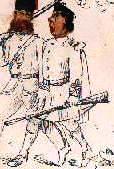 In 1859 the United Kingdom was threatened with
invasion by Napoleon III of France. This led to the raising of
Rifle and Artillery Volunteer Corps for the purposes of meeting
such an invasion. Queen Victoria signified her acceptance of a
Corps of Volunteers under the title of 'The Liverpool Scottish
Rifle Volunteers (XIXth Lancashire)'. There were two companies, a
Lowland company and a Highland company, which wore the MacKenzie
tartan. These units were, in general, equipped and maintained at
their own expense; members paid a subscription and bought their
own uniforms and, in many cases, their commanders maintained them
at their own expense. William Brown, a great commercial power in
Liverpool, raised and commanded the 1st. Liverpool Artillery
Volunteers at the age of 75 and is reputed to have contributed
£3000 per annum to their expenses (a figure that is equivalent
to over £300,000 today). The Rifle Volunteer movement placed
great emphasis on shooting and drill (and, apparently,
conviviality) as these three Victorian sketches with their cut-out caricature
heads might suggest. They are 'The Butts', the immaculate drill
of 'The March Past Before the Review' (sadly with some headless
warriors) and the rather less orderly 'March Past After the
Review'. The faces are respectable, well-fed and professional,
perhaps reflecting the Volunteer movement of the time.
In 1859 the United Kingdom was threatened with
invasion by Napoleon III of France. This led to the raising of
Rifle and Artillery Volunteer Corps for the purposes of meeting
such an invasion. Queen Victoria signified her acceptance of a
Corps of Volunteers under the title of 'The Liverpool Scottish
Rifle Volunteers (XIXth Lancashire)'. There were two companies, a
Lowland company and a Highland company, which wore the MacKenzie
tartan. These units were, in general, equipped and maintained at
their own expense; members paid a subscription and bought their
own uniforms and, in many cases, their commanders maintained them
at their own expense. William Brown, a great commercial power in
Liverpool, raised and commanded the 1st. Liverpool Artillery
Volunteers at the age of 75 and is reputed to have contributed
£3000 per annum to their expenses (a figure that is equivalent
to over £300,000 today). The Rifle Volunteer movement placed
great emphasis on shooting and drill (and, apparently,
conviviality) as these three Victorian sketches with their cut-out caricature
heads might suggest. They are 'The Butts', the immaculate drill
of 'The March Past Before the Review' (sadly with some headless
warriors) and the rather less orderly 'March Past After the
Review'. The faces are respectable, well-fed and professional,
perhaps reflecting the Volunteer movement of the time.
Return to Main Page / Return to Top of This Page / Contact
the Museum
1900-1914
Foundation
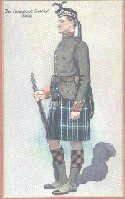 The Liverpool Scottish was formed as an infantry
battalion in 1900 in response to the crisis of the Boer War. It
was raised from amongst the body of highly educated and
professional young Scotsmen in the city as the 8th (Scottish)
Volunteer Battalion, The King's (Liverpool Regiment). There was
an annual subscription of 10 shillings (50p) and an entrance fee
of £2. The first Commanding Officer was Colonel C. Forbes Bell
V.D.
The Liverpool Scottish was formed as an infantry
battalion in 1900 in response to the crisis of the Boer War. It
was raised from amongst the body of highly educated and
professional young Scotsmen in the city as the 8th (Scottish)
Volunteer Battalion, The King's (Liverpool Regiment). There was
an annual subscription of 10 shillings (50p) and an entrance fee
of £2. The first Commanding Officer was Colonel C. Forbes Bell
V.D. The Forbes tartan kilt was
adopted by the regiment and the Highland
full dress uniform featured a khaki tunic with scarlet collar and
facings together with a feather bonnet or glengarry and tartan
plaid. A party of 22 men went to South Africa with the 4th
Service Company of the Gordon Highlanders and were attached to
the 1st. Battalion of that regiment. An account of volunteer
service in South Africa with the 1st Service Company of the
Gordon Highlanders can be found here. With HQ established in Fraser
Street in the Liverpool city centre, the home of the Scottish
until 1967, the Battalion was redesignated in 1908 on the
establishment of the Territorial Force as the 10th
(Scottish) Battalion, The King's (Liverpool Regiment).The link shows bonnet and
sporran badges of the new battalion.
The Forbes tartan kilt was
adopted by the regiment and the Highland
full dress uniform featured a khaki tunic with scarlet collar and
facings together with a feather bonnet or glengarry and tartan
plaid. A party of 22 men went to South Africa with the 4th
Service Company of the Gordon Highlanders and were attached to
the 1st. Battalion of that regiment. An account of volunteer
service in South Africa with the 1st Service Company of the
Gordon Highlanders can be found here. With HQ established in Fraser
Street in the Liverpool city centre, the home of the Scottish
until 1967, the Battalion was redesignated in 1908 on the
establishment of the Territorial Force as the 10th
(Scottish) Battalion, The King's (Liverpool Regiment).The link shows bonnet and
sporran badges of the new battalion.
Return to Main Page / Return to Top of This Page / Contact
the Museum
1914 -1920
Mobilisation
 In 1914 the Liverpool Scottish was mobilised at
the outset of war and moved to France on 1st/2nd November 1914,
one of the first Territorial battalions to do so. They sailed to
France aboard the S.S. Maidan and an account of the
time-consuming crossing by a Senior NCO of the Queen's
Westminsters (who shared the ship with the Liverpool Scottish)
can be found here. At this stage of the war,
officers still carried swords.... but not for long! The Battalion
was made up from the outset of the war by men of high calibre,
educated professionals and businessmen such as Arthur Hopley. During the course of the War,
over 600 of its soldiers were to be commissioned and the Museum
has carefully researched these names to yield a fascinating
picture of the social composition of The Liverpool Scottish. The
details of the new WW1 history of the Liverpool Scottish, 'Bravest
of Hearts',
by Hal Giblin with David Evans and Dennis Reeves can be found here.
In 1914 the Liverpool Scottish was mobilised at
the outset of war and moved to France on 1st/2nd November 1914,
one of the first Territorial battalions to do so. They sailed to
France aboard the S.S. Maidan and an account of the
time-consuming crossing by a Senior NCO of the Queen's
Westminsters (who shared the ship with the Liverpool Scottish)
can be found here. At this stage of the war,
officers still carried swords.... but not for long! The Battalion
was made up from the outset of the war by men of high calibre,
educated professionals and businessmen such as Arthur Hopley. During the course of the War,
over 600 of its soldiers were to be commissioned and the Museum
has carefully researched these names to yield a fascinating
picture of the social composition of The Liverpool Scottish. The
details of the new WW1 history of the Liverpool Scottish, 'Bravest
of Hearts',
by Hal Giblin with David Evans and Dennis Reeves can be found here.
Early Into The Trenches
The
Battalion reorganised from the 'eight company' system to the
Regular Army's 'double company' organisation, numbering its
companies from No. 1 to No. 4 and subsequently renaming them
(previously A to G) as V, X, Y and Z, possibly a unique lettering
system in that it survived until 1999. It entered the front line
at the end of November 1914, 26 officers and 829 other ranks
strong. By the end of January 1915 following terrible winter
weather the total strength had fallen to 370.  The Museum holds an excellent
series of photographs of the early days at
the front.
The Regimental Historian records that actual battle losses
accounted for 32, the remainder were mostly victims of
trench-foot. Much of this early period was spent near Ieper
(Ypres) and a lithograph by Sir Muirhead Bone of the area
beteween Kemmel and Ieper is shown here. It was published in 1916 but
gives a good idea of the open nature of the country.
The Museum holds an excellent
series of photographs of the early days at
the front.
The Regimental Historian records that actual battle losses
accounted for 32, the remainder were mostly victims of
trench-foot. Much of this early period was spent near Ieper
(Ypres) and a lithograph by Sir Muirhead Bone of the area
beteween Kemmel and Ieper is shown here. It was published in 1916 but
gives a good idea of the open nature of the country.
Battle of
Hooge (First Action at Bellewaarde)
The first
major battalion action of the Liverpool Scottish was on 16th.
June 1915 in what is officially known as 'The First Action at
Bellewaarde' which was designed to pin down German reserves
whilst there were British and French attacks elsewhere.This
action is known in The Liverpool Scottish as 'The Battle of
Hooge'. Hooge is a village is a few miles East of Ieper (Ypres),
straddling the Menin Road (click here for a more detailed map). 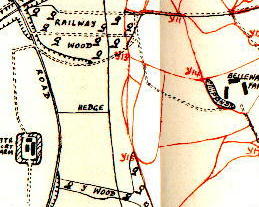 The Liverpool Scottish, as part of 9th Brigade (
in turn part of the 3rd Division of the Regular Army) , were to
take part in the second phase of the attack on ground just North
of The Menin Road between (and including) Railway Wood (still to
be seen) in the North and a hedge row seen on the map (just North
of a feature known as Y-Wood to the South which no longer
exists). They were to be the left hand battalion and to their
right was to be a battalion of the Lincolns. The battalion's
frontage appears to have been about 400 yards. The assembly
position was on the line of 'Cambridge Road', a feature which
exists today as a metalled track running North from the Menin
Road and a Liverpool Scottish memorial was unveiled and dedicated
here on Saturday 29th July 2000 during the centenary year, a
project in which the Museum was actively involved. Detail is on
The Liverpool Scottish, as part of 9th Brigade (
in turn part of the 3rd Division of the Regular Army) , were to
take part in the second phase of the attack on ground just North
of The Menin Road between (and including) Railway Wood (still to
be seen) in the North and a hedge row seen on the map (just North
of a feature known as Y-Wood to the South which no longer
exists). They were to be the left hand battalion and to their
right was to be a battalion of the Lincolns. The battalion's
frontage appears to have been about 400 yards. The assembly
position was on the line of 'Cambridge Road', a feature which
exists today as a metalled track running North from the Menin
Road and a Liverpool Scottish memorial was unveiled and dedicated
here on Saturday 29th July 2000 during the centenary year, a
project in which the Museum was actively involved. Detail is on
Attack
The
Battalion moved off into the attack uphill towards Bellewaarde
Farm (the ridge line is today occupied by the CWGC Cross of
Remembrance of the RE Grave) at a strength of 23 Officers and 519
Other Ranks. At the end of the day, there
were 2 Officers and 140 ORs unscathed. There were 4 Officers and
75 ORs killed, 6 Officers and 108 ORs missing (of whom almost all
were later reported killed) and 11 Officers and 201 ORs wounded.
An indication of the scale of the casualties is that the account
of the action in the war diary is signed by Lieutenant L.G. Wall
as Commanding Officer of The Liverpool Scottish. Amongst the dead
were Lt. Kenneth Alexander Gemmell, 2/Lt
John Christian Barber and Capt. Bryden McKinnell M.C. whose fine
portraits hung until recently in the Liverpool Scottish Officers'
Mess and are now to be found a new home.
At the end of the day, there
were 2 Officers and 140 ORs unscathed. There were 4 Officers and
75 ORs killed, 6 Officers and 108 ORs missing (of whom almost all
were later reported killed) and 11 Officers and 201 ORs wounded.
An indication of the scale of the casualties is that the account
of the action in the war diary is signed by Lieutenant L.G. Wall
as Commanding Officer of The Liverpool Scottish. Amongst the dead
were Lt. Kenneth Alexander Gemmell, 2/Lt
John Christian Barber and Capt. Bryden McKinnell M.C. whose fine
portraits hung until recently in the Liverpool Scottish Officers'
Mess and are now to be found a new home. Captain McKinnell wrote a fine
diary which has been used as a source in major works on the Great
War. Additionally, there exist amazing photographs of the attack,
taken by Private F.A. Fyfe of Z Company as he lay wounded by the
German front line, showing soldiers of The Scottish advancing
under fire and an artillery officer and his signaller crossing
the German parapet with wounded soldiers in the foreground. Fyfe
was a press photographer by profession and his (illegal) photographs made the front pages
of the national press a short while later.
Captain McKinnell wrote a fine
diary which has been used as a source in major works on the Great
War. Additionally, there exist amazing photographs of the attack,
taken by Private F.A. Fyfe of Z Company as he lay wounded by the
German front line, showing soldiers of The Scottish advancing
under fire and an artillery officer and his signaller crossing
the German parapet with wounded soldiers in the foreground. Fyfe
was a press photographer by profession and his (illegal) photographs made the front pages
of the national press a short while later.
Awards for
Valour and Distinguished Conduct
It was for
his efforts in this action that the Battalion's medical officer, Lt. Noel
Chavasse,
(later Captain) received the Military Cross. He was later to
receive the Victoria Cross in 1916 and, posthumously, a Bar to
his VC in 1917. Few other awards were made for the action at
Hooge; it is said that the list of recommendations was lost in a
fire at Brigade HQ. Three men (Cpl. S. Smith, Private W. Short
and Pte. F.F. Bell) received the Distinguished Conduct Medal
(DCM) on the recommendation of other battalions. Belatedly, ten
men were awarded the Military Medal on its inception in 1916 for
their work at Hooge the previous year. Altogether the Regimental
Historian lists 293 names in the list of honours and awards for
service during the Great War. One recipient of the Military Medal
was the highly articulate and well-educated Regimental Quarter
Master Sergeant, R.A. Scott
Macfie,
who later became a world expert on Gypsies and some of whose
meticulously written field notebooks form part of the Museum
collection. The Imperial War Museum also holds some Scott McFie
material and has made use of it in IWM publications
Other
Great War Battalions
During the
course of the Great War, The Liverpool Scottish continued to see
front line action in France and Belgium, joining the 55th (West Lancashire) Division with its motto 'They
win or die who wear the rose of Lancaster', and a second
battalion (2nd/10th) was formed in 1914 and served in France from
1917. A cigarette case inscribed with the insignia of the 57th (2nd West Lancashire)
Division
with which the 2nd Battalion served is shown here. A third battalion (3rd/10th)
formed in 1915, based for most of the war at Oswestry, acted as a
draft finding battalion.
Return to Main Page / Return to Top of This Page / Contact
the Museum
1920-1939
Between
the Wars - The Queen's Own Cameron Highlanders
In 1920,
The Liverpool Scottish reformed as the 10th (Liverpool Scottish)
Battalion, The King's Regiment (Liverpool) TA but in 1937 was
officially redesignated as The Liverpool Scottish, The Queen's
Own Cameron Highlanders to become an integral Territorial
battalion of the Cameron
Highlanders.
The bonnet badge changed to a Liverpool
Scottish
version of the Cameron badge. A caricature sketch of the Officers
Mess in 1937 can be seen here. Colours were presented to the
battalion by H.M. King George VI at Goodison Park football ground
in 1938. A second battalion was formed immediately before the
outbreak of war in 1939.
Return to Main Page / Return to Top of This Page / Contact
the Museum
1939 - 1947
The Second
World War
During the
1939-45 war, the 1st Battalion of The Liverpool Scottish remained
in Great Britain but found many reinforcements for The Queen's
Own Cameron Highlanders battalions (and other Highland regiments)
on active service overseas. Details of typical Liverpool Scottish
service in WW2 can be found on the site of George Sands MM who joined the Camerons in
1939, served with both battalions of the Liverpool Scottish and
then with both the 4th and the 5th Battalions of the Camerons,
winning the MM with the 5th Camerons in 1944 in Normandy.
Additionally
the 1st and 2nd. Battalions of the Liverpool Scottish provided a
contingent for No. 4 Independent Company which went to Norway in
1940 to face the German invasion. Subsequently, many members
served with the Army Commandos including Captain Donald Roy DSO,
decorated for his courage and skill in the raid on St. Nazaire in 1942 in which many other
Liverpool Scots took part. Donald Roy, known as 'The Laird',
insisted that his men wore kilts both in training and in action.
Details of the book, 'Storming St. Nazaire' can be found here
The long-awaited book Special Service
of a Hazardous Nature: The Story of the Liverpool Scottish Involvement in
Special Operations during WW2 was published in October 2007 (compiled by
Dennis Reeves) and is available only through the Museum
shop.
The 2nd.
Battalion, The Liverpool Scottish, also supplied reinforcements
for Highland regiments and, after serving in a home defence role,
converted to the 89th Anti-Tank Regiment, Royal Artillery,
disbanding in 1946. The 1st. Battalion served in Gibraltar from
1945 to 1947. Another major Museum project has been to identify
the names and details of men of The Liverpool Scottish who died
serving with other units such as 56th Recce Regt . This research continues and
any additional information would be welcomed. Anyone who would
like to look at the casualty database of Liverpool Scots should
contact the Hon. Secretary.
Return to Main Page / Return to Top of This Page / Contact
the Museum
1947 - 1967
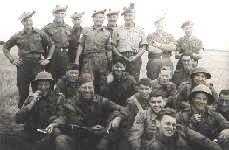 The
1st Battalion The Liverpool Scottish reformed at the Fraser Street Drill Hall
in Liverpool in 1947 and, until its disbandment in 1967 when the
Territorial Army was reorganised, it was firstly a motor
battalion and then an infantry battalion. The battalion won the
Territorial Army Shield in the Duke of Edinburgh's Trophy
Competition in 1957 and 1960. A winning team is shown here without names. (Photo courtesy of Major James
Bruxner CBE
- a
identification key will be placed here in the near future). Members of the Liverpool
Scottish may care to see who they can identify and a named
copy of the photograph is added here. If any more soldiers can be
identified please contact the Museum. After the amalgamation of The
Queen's Own Cameron Highlanders with the Seaforth Highlanders in
1961, the battalion continued in Forbes tartan as The Liverpool
Scottish, a part of the amalgamated regiment, The
Queen's Own Highlanders, but continuing to wear the buttons of the
Queen's Own Cameron Highlanders
The
1st Battalion The Liverpool Scottish reformed at the Fraser Street Drill Hall
in Liverpool in 1947 and, until its disbandment in 1967 when the
Territorial Army was reorganised, it was firstly a motor
battalion and then an infantry battalion. The battalion won the
Territorial Army Shield in the Duke of Edinburgh's Trophy
Competition in 1957 and 1960. A winning team is shown here without names. (Photo courtesy of Major James
Bruxner CBE
- a
identification key will be placed here in the near future). Members of the Liverpool
Scottish may care to see who they can identify and a named
copy of the photograph is added here. If any more soldiers can be
identified please contact the Museum. After the amalgamation of The
Queen's Own Cameron Highlanders with the Seaforth Highlanders in
1961, the battalion continued in Forbes tartan as The Liverpool
Scottish, a part of the amalgamated regiment, The
Queen's Own Highlanders, but continuing to wear the buttons of the
Queen's Own Cameron Highlanders
Return to Main Page / Return to Top of This Page / Contact
the Museum
1967 - 1999
V (The
Liverpool Scottish) Company
In April
1967, The Liverpool Scottish reformed as V (The Liverpool
Scottish) Company, 51st. Highland Volunteers AVR II with
battalion HQ in Perth. The company adopted the Highland Brigade
bonnet badge (a stag's head upon a saltire) worn on a cloth
Forbes tartan background and continued to wear the blue hackle of
The Queen's Own Highlanders. The Forbes tartan kilt (as with all
other forms of dress) was retained. On leaving Fraser Street, a
new HQ for the Territorial company was established at the TA
barracks in Score Lane in Childwall (a Liverpool suburb) which
had previously been Signal House. It was renamed Forbes House.
The Liverpool Scottish tradition was thus blended for the next
twenty five years with that of the famous 51st Highland Division.
An article 'Saturday
Night Soldiers - The Territorials to 1973' was written by the second
commanding officer of the Highland Volunteers, Lt. Col. the Hon.
W.D. Arbuthnott, Black Watch. Some of the history of Forbes House
previous to the arrival of the Liverpool Scottish can be found at
the website of 42 Signal Squadron TA
R
(King's/Liverpool Scottish) Battery, West Lancashire Regiment RA
AVR III was also raised at Forbes House. In 1969, R Battery was
disbanded. An account of R Battery has been written by Lt Col
Tony Moore (see bibliography). V Company continued to serve with
the newly formed 1st. Battalion, 51st. Highland Volunteers.
Excitement at Annual Camp - the Akamas
Penisula, Cyprus
In 1974,
whilst V Company were attending its annual two weeks training in
Cyprus, the government of Archbishop Makarios was overthrown by
Greek nationalists. V Company was on exercise in the far west of
the island at an isolated location in the Akamas Peninsula. This
area was outside the Sovereign Base Areas. After some days of
considerable uncertainty, punctuated by forest fires and the
arrival of British service families stranded in the area together
with resupply by sea, the company was evacuated through the Greek
areas around Paphos to the British Sovereign Base Area at
Akrotiri. There they witnessed some of the civil strife which
broke out between the two communities in Cyprus when the Turkish
Army invaded the north of the island.
 Play
the Pipe Tune: The Evacuation of Cyprus 1974 [believed to be composed composed by P/M RS
Burns and which is to be found at page 39 of the Royal Scots Standard
Settings (Paterson) - information courtesy of Major
Richard Powell FSA Scot
Play
the Pipe Tune: The Evacuation of Cyprus 1974 [believed to be composed composed by P/M RS
Burns and which is to be found at page 39 of the Royal Scots Standard
Settings (Paterson) - information courtesy of Major
Richard Powell FSA Scot
Colours
Presentation
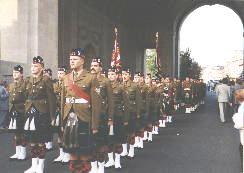 Colours were presented to the
1st. Battalion, 51st Highland Volunteers by H.M Queen Elizabeth,
The Queen Mother, on the North Inch at Perth in 1986. A guard was
found by V (The Liverpool Scottish) Company.
Colours were presented to the
1st. Battalion, 51st Highland Volunteers by H.M Queen Elizabeth,
The Queen Mother, on the North Inch at Perth in 1986. A guard was
found by V (The Liverpool Scottish) Company.
Apart from
remaining a well-trained and well recruited infantry company, V
Company remained conscious of its history and during the 1990's
made made several visits to the battlefield of Hooge near Ypres
(Ieper). On the occasion shown
here the company had marched from Hooge down the Menin Road to enter Ieper by the Menin Gate
for the Last Post
Ceremony.
Change of
Battalion
In
September 1992, V Company
marched off the square at Otterburn as the Champion Company and
bade farewell to Lt. Colonel David Thorneycroft and the 51st
Highland Volunteers. Subsequently in October 1992, the Company
was transferred and redesignated as V (The Liverpool Scottish)
Company, 5th/8th. (Volunteer) Battalion, The King's Regiment with
battalion HQ at Warrington under the command of Lt. Colonel
Martin Amlôt. The Company gave up the Highland Brigade badge and
returned to the bonnet badge of the 10th (Scottish) Battalion of
the King's (Liverpool) Regiment, first introduced in 1908 until
replaced by the Liverpool Scottish version of the Cameron badge
in 1937. The blue hackle continued to be worn. You may reach the
official website of the King's Regiment by clicking here
5th/8th.
(Volunteer) Battalion, The King's Regiment
V Company
enjoyed a successful debut in the new battalion, winning the
Champion Company banner in their first year. In 1998 the Ashton
Trophy
was first awarded. This was as a result of a bequest of Harley
Watson in memory of his Great War friend, Charles Norman Ashton.
In 1999 past and present members of The Liverpool Scottish said
farewell to Forbes House, their HQ, as a result of the
reorganisation of the Territorial Army and the disbandment of the
Liverpool Scottish company.
Return to Main Page / Return to Top of This Page / Contact
the Museum
1999-
In July
1999, 50 Liverpool Scottish soldiers, retaining their distinctive
bonnet badge, their Highland dress and their regimental customs,
were redeployed under Lt Col David Richardson MBE to form part of
a new Territorial infantry battalion, The King's and Cheshire Regiment. Their new location is with A (King's) Company at TA Centre, Townsend Avenue, Liverpool L11 5AS whilst there is a
Liverpool Scottish element to the Reconnaissance Platoon of KCR
based in Manchester. The Museum has relocated in Liverpool and is
redeveloping its displays. Official opening is to take place in mid-November
2002. However contact is through the address
given at the contact page (see below).
The
centenary year of 2000 has been marked by a Centenary Ball at St.
George's Hall in May 2000. Photos of the Ball may be seen by
clicking here. The Museum is organising the
sponsoring and planting of 'Scottish Wood' at Altcar Range north
of Liverpool and the dedication of this was to have taken place
in May 2001. This was postponed until 2002 as a result of Foot and
Mouth disease (Details from the Hon Secretary of the Museum to
whom donations towards the cost of trees in memory of family
members who served in the Liverpool Scottish may be made).
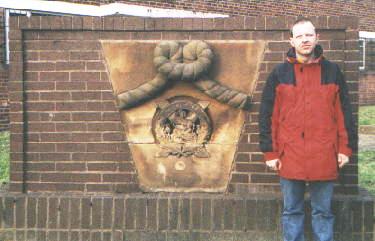 Additionally,
the Museum was closely involved in the arrangements for the
relocation of the stone Liverpool Scottish badge (10th King's)
which was originally the keystone to the entrance at the
Liverpool Scottish HQ at the Fraser Street Barracks in the centre
of Liverpool and subsequently mounted in a plinth at Forbes
House, the HQ of V (The Liverpool Scottish) Company, in the
Childwall area of Liverpool.
Additionally,
the Museum was closely involved in the arrangements for the
relocation of the stone Liverpool Scottish badge (10th King's)
which was originally the keystone to the entrance at the
Liverpool Scottish HQ at the Fraser Street Barracks in the centre
of Liverpool and subsequently mounted in a plinth at Forbes
House, the HQ of V (The Liverpool Scottish) Company, in the
Childwall area of Liverpool.

 It
was placed on the battlefield
at Hooge
near Ypres (Ieper) in Belgium on July 29th 2000 and was be handed
over to the town of Ieper by the Lord Mayor of Liverpool during a
service conducted by the Rev. Canon Nicholas Frayling, Rector of
Liverpool. It is to serve as a memorial to all Liverpool Scots
who have died in the service of their country. Detail
can be found on a dedicated webpage
It
was placed on the battlefield
at Hooge
near Ypres (Ieper) in Belgium on July 29th 2000 and was be handed
over to the town of Ieper by the Lord Mayor of Liverpool during a
service conducted by the Rev. Canon Nicholas Frayling, Rector of
Liverpool. It is to serve as a memorial to all Liverpool Scots
who have died in the service of their country. Detail
can be found on a dedicated webpage
 A further visit to Ieper was made during weekend of 15th/16/17thth June 2002
to mark the Last Post Ceremony on Sunday 16th June 2002 commemorating Acting Sgt. Charles William Ormesher who was
listed missing on 16th June 1915 at the Battle of Hooge but has
never been listed as 'killed' by the Commonwealth War Graves
Commission. Consequently, there was no memorial to Ormesher.
The Commonwealth War Graves Commission accepted the Museum's
case and his name has now been inscribed on the Menin Gate. (Addenda panel on
the external SW corner of the Menin Gate)
A further visit to Ieper was made during weekend of 15th/16/17thth June 2002
to mark the Last Post Ceremony on Sunday 16th June 2002 commemorating Acting Sgt. Charles William Ormesher who was
listed missing on 16th June 1915 at the Battle of Hooge but has
never been listed as 'killed' by the Commonwealth War Graves
Commission. Consequently, there was no memorial to Ormesher.
The Commonwealth War Graves Commission accepted the Museum's
case and his name has now been inscribed on the Menin Gate. (Addenda panel on
the external SW corner of the Menin Gate)
In June 2005, following
extensive research and in conjunction with the authorities of the communities
of Erquinghem Lys and Bois Grenier in north eastern France (near
Armentières), a party of serving soldiers accompanied by approximately 100
supporters led by the President of the Officers' Association (and Lord
Lieutenant of Merseyside), Colonel Alan Waterworth, visited the area in which
the 2nd Battalion of the Liverpool Scottish [2/10th (Scottish)
Battalion, The King's (Liverpool Regiment) TF] served with the 57th (2nd
West Lancashire) Division in 1917. A memorial cairn to the men of the 2nd
Battalion was unveiled 1 km south of Bois Grenier near to the start point
of their 'Dicky's Dash' trench raid of 1917.
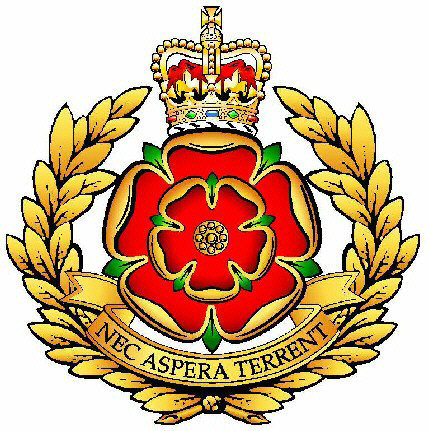 From
2006 (during a period from from July 1st), the Kings and Cheshire Regiment of
the Territorial Army was reorganized
and the King's Regiment companies (A and C Company), including the Liverpool
Scottish element joined the 4th Battalion The
Duke of Lancaster's Regiment (King's, Lancashire and Border). Private
soldiers continue to be known as 'Kingsmen'. The 1908 pattern 10th King's
Liverpool Regiment badge, readopted in 1993 on transfer from the 1st Battalion
51st Highland Volunteers to the 5th/8th Battalion, The King's Regiment and that
continued to be worn by V (The Liverpool Scottish) Company in the King's
and Cheshire Regiment, has been replaced by the Duke of
Lancaster's badge seen to the right, worn on the TOS. The Regiment is known in
speech as "The Duke of Lancaster's" and the territorial battalion has
the designation 4 LANCS. The Liverpool Scottish rifle platoon is part of A
(Ladysmith) Company of 4 LANCS, based at the TA Centre at Townsend Avenue in
Liverpool. During this period members of the Liverpool Scottish have been on
active service in the various phases of Operation Telic in Iraq as well as
being deployed in Afghanistan. The blue hackle continues to be worn.
From
2006 (during a period from from July 1st), the Kings and Cheshire Regiment of
the Territorial Army was reorganized
and the King's Regiment companies (A and C Company), including the Liverpool
Scottish element joined the 4th Battalion The
Duke of Lancaster's Regiment (King's, Lancashire and Border). Private
soldiers continue to be known as 'Kingsmen'. The 1908 pattern 10th King's
Liverpool Regiment badge, readopted in 1993 on transfer from the 1st Battalion
51st Highland Volunteers to the 5th/8th Battalion, The King's Regiment and that
continued to be worn by V (The Liverpool Scottish) Company in the King's
and Cheshire Regiment, has been replaced by the Duke of
Lancaster's badge seen to the right, worn on the TOS. The Regiment is known in
speech as "The Duke of Lancaster's" and the territorial battalion has
the designation 4 LANCS. The Liverpool Scottish rifle platoon is part of A
(Ladysmith) Company of 4 LANCS, based at the TA Centre at Townsend Avenue in
Liverpool. During this period members of the Liverpool Scottish have been on
active service in the various phases of Operation Telic in Iraq as well as
being deployed in Afghanistan. The blue hackle continues to be worn.
Return to Main Page / Return to Top of This Page / Contact
the Museum
Back
To The Main Page
Contact
the Museum
 In 1859 the United Kingdom was threatened with
invasion by Napoleon III of France. This led to the raising of
Rifle and Artillery Volunteer Corps for the purposes of meeting
such an invasion. Queen Victoria signified her acceptance of a
Corps of Volunteers under the title of 'The Liverpool Scottish
Rifle Volunteers (XIXth Lancashire)'. There were two companies, a
Lowland company and a Highland company, which wore the MacKenzie
tartan. These units were, in general, equipped and maintained at
their own expense; members paid a subscription and bought their
own uniforms and, in many cases, their commanders maintained them
at their own expense. William Brown, a great commercial power in
Liverpool, raised and commanded the 1st. Liverpool Artillery
Volunteers at the age of 75 and is reputed to have contributed
£3000 per annum to their expenses (a figure that is equivalent
to over £300,000 today). The Rifle Volunteer movement placed
great emphasis on shooting and drill (and, apparently,
conviviality) as these three Victorian sketches with their cut-out caricature
heads might suggest. They are 'The Butts', the immaculate drill
of 'The March Past Before the Review' (sadly with some headless
warriors) and the rather less orderly 'March Past After the
Review'. The faces are respectable, well-fed and professional,
perhaps reflecting the Volunteer movement of the time.
In 1859 the United Kingdom was threatened with
invasion by Napoleon III of France. This led to the raising of
Rifle and Artillery Volunteer Corps for the purposes of meeting
such an invasion. Queen Victoria signified her acceptance of a
Corps of Volunteers under the title of 'The Liverpool Scottish
Rifle Volunteers (XIXth Lancashire)'. There were two companies, a
Lowland company and a Highland company, which wore the MacKenzie
tartan. These units were, in general, equipped and maintained at
their own expense; members paid a subscription and bought their
own uniforms and, in many cases, their commanders maintained them
at their own expense. William Brown, a great commercial power in
Liverpool, raised and commanded the 1st. Liverpool Artillery
Volunteers at the age of 75 and is reputed to have contributed
£3000 per annum to their expenses (a figure that is equivalent
to over £300,000 today). The Rifle Volunteer movement placed
great emphasis on shooting and drill (and, apparently,
conviviality) as these three Victorian sketches with their cut-out caricature
heads might suggest. They are 'The Butts', the immaculate drill
of 'The March Past Before the Review' (sadly with some headless
warriors) and the rather less orderly 'March Past After the
Review'. The faces are respectable, well-fed and professional,
perhaps reflecting the Volunteer movement of the time.












